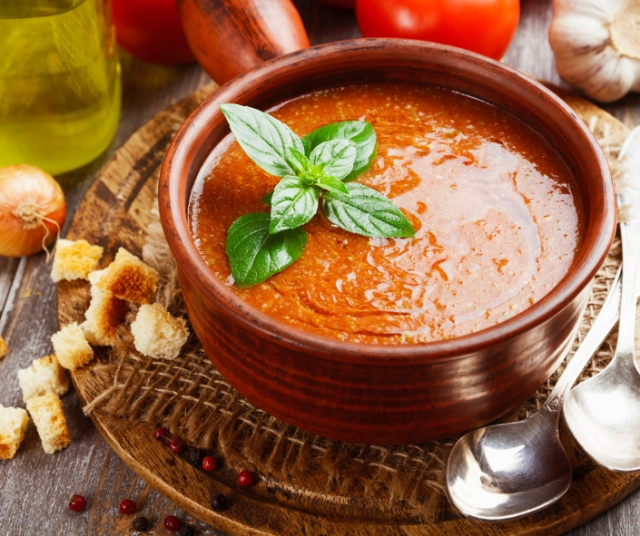Spanish Gazpacho is a cold and refreshing soup that has its roots in the southern region of Spain, especially Andalusia. This traditional recipe has conquered palates around the world thanks to its unique combination of fresh flavors and soft texture. Originally from the Andalusian countryside, gazpacho has evolved over time and has become an emblematic dish of Spanish gastronomy.
History of Gazpacho:
The history of Gazpacho is as rich and varied as its fresh ingredients. This emblematic dish has its roots in medieval Spain, specifically in the Andalusia region. The name "gazpacho" is believed to come from the Mozarabic "dandruff," which refers to scraps or crumbs, suggesting that this soup originated as an ingenious way to use up leftover bread.
During Roman times, in the Iberian Peninsula, a preparation called "puls" was consumed, a mixture of bread, oil and vinegar that resembles modern gazpacho in some ways. However, it was in the Middle Ages when gazpacho began to take the form we know today. Andalusian farmers, who worked long hours under the scorching sun, needed a food that would provide them with energy and relief from the heat. Thus, gazpacho became a refreshing soup, thanks to the incorporation of ingredients such as tomatoes, peppers and cucumbers, which were introduced to Spain from America during the Columbian exchange.
Over time, gazpacho evolved and adapted to local tastes and seasonal availability. Each region of Spain has its own variant, from Gazpacho Andaluz, the best known, to Gazpacho Manchego, which incorporates meat, or Gazpacho Extremeño, which is served with grapes. This diversity reflects the cultural richness of Spain and the ability of gastronomy to adapt to local resources and regional preferences.
During the 19th century, gazpacho began to gain popularity outside of Spain, especially among travelers exploring the Iberian Peninsula. Its reputation as a healthy and refreshing soup was consolidated, and the recipe began to spread throughout the world, being reinterpreted and adapted in different international cuisines.
Today, Spanish Gazpacho is not only enjoyed on the streets of Seville or Granada during the warm summer months, but it has also transcended borders, becoming an internationally recognized dish.
Essential Ingredients:
Juicy Tomatoes:
6-8 ripe tomatoes.
Pear or Raf variety tomatoes are ideal.
Fresh Cucumber:
1 large cucumber, peeled and cut into pieces.
Green pepper:
1 green pepper, seeded and chopped.
Sweet onion:
1 medium onion, peeled and cut into pieces.
Garlic:
2 cloves of garlic, peeled.
Stale bread:
2 cups of stale bread, preferably from the day before, cut into pieces.
Extra Virgin Olive Oil:
1/2 cup high quality olive oil.
Red Wine Vinegar:
3 tablespoons of red wine vinegar.
Salt and pepper:
To taste.
Steps
Step 1: Preparation of Ingredients
Start by washing and cutting all the vegetables into large pieces. Make sure to peel the cucumber and onion.
Step 2: Soaking the Bread
Place the stale bread in a bowl and cover with water. Let it soak for about 10 minutes until it is well soaked.
Step 3: Mix in the Blender
In a blender, add the tomatoes, cucumber, green pepper, onion, garlic and soaked bread. Blend until you obtain a smooth mixture.
Step 4: Add Oil and Vinegar
With the blender running, slowly pour in the extra virgin olive oil and red wine vinegar. Continue mixing until all the ingredients are well incorporated.
Step 5: Adjust Seasoning
Taste the mixture and adjust the salt and pepper according to your taste. If necessary, you can add more oil or vinegar to balance the flavors.
Step 6: Cooling
Transfer the mixture to a container and refrigerate for at least 2 hours so the flavors blend and the soup takes on its characteristic refreshing flavor.
Step 7: Serve
Serve the gazpacho in individual bowls. You can garnish each serving with small pieces of cucumber, tomato or pepper to give it an attractive visual touch.
Practical tips:
Mature tomatoes:
Use very ripe tomatoes to obtain a tastier gazpacho. If possible, opt for tomatoes from local and seasonal varieties.
Personal Fit:
Gazpacho is a versatile recipe. If you prefer a thicker texture, you can reduce the mixing time. Experiment with the amount of garlic, vinegar, and oil to find the perfect balance based on your preferences.
Creative Accompaniments:
If you want to take your gazpacho to the next level, try serving it with ice cubes or small pieces of avocado. These add additional texture and a touch of freshness.
